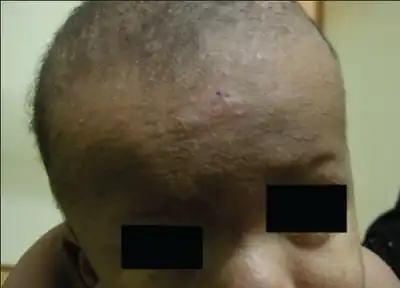Cardiofaciocutaneous syndrome
| Cardiofaciocutaneous syndrome | |
|---|---|
 | |
| Cardiofaciocutaneous syndrome is inherited in an autosomal dominant manner[1] | |
Cardiofaciocutaneous (CFC) syndrome is an extremely rare genetic disorder, and is one of the RASopathies. It was first described in 1986.[2][3][4]
Symptoms and signs

It is characterized by the following:
- Distinctive facial appearance
- Unusually sparse, brittle, curly scalp hair
- A range of skin abnormalities from dermatitis to thick, scaly skin over the entire body (generalized ichthyosis)
- Heart malformations in over 75% of patients[4] (congenital or appearing later), especially an obstruction of the normal flow of blood from the lower right ventricle of the heart to the lungs (valvar pulmonary stenosis)
- Growth delays
- Feeding problems associated with severe gastroesophageal reflux disease (GERD)[4]
- Foot abnormalities (extra toe or fusion of two or more toes)
- Intellectual disability[4]
- Failure to thrive[4]
Individuals with the disorder usually have distinctive malformations of the craniofacial area including an unusually large head (macrocephaly), prominent forehead, and abnormal narrowing of both sides of the forehead (bitemporal constriction); The nose can be upturned and short with a low nasal bridge; and large ears that are abnormally rotated toward the back of the head. In many cases, affected individuals also have downward slanting eyelid folds, widely spaced eyes, drooping of the upper eyelids, inward deviation of the eyes, and other eye abnormalities including absent eyebrows and eyelashes.
Genetic
Costello and Noonan syndrome are similar to CFC and their phenotypic overlap may be due to the biochemical relationship of the genes mutated in each syndrome. Genes that are mutated in all three of these syndromes encode proteins that function in the MAP kinase pathway.
- Mutations that cause CFC are found in the KRAS, BRAF, MEK1, and MEK2 genes.
- Costello syndrome is caused by mutations in HRAS.
- Mutations that cause Noonan syndrome have been found in PTPN11 and SOS1.
The relative severity of CFC when compared to Noonan syndrome may reflect the position in the biochemical pathway occupied by the affected genes.
- Shp2, the protein product of the PTPN11 gene, appears to regulate the MAP kinase pathway at or above the level of SOS1.
- SOS1 in turn regulates the activities of RAS, RAF, MEK, ERK, and p90RSK.
- SOS1 has been demonstrated to be a target of negative feedback by ERK and p90RSK.
Thus, any activating mutation downstream of SOS1 may be subject to less regulation that might mitigate the consequence of such mutations, giving rise to the phenotypic differences seen between these syndromes.[5]
Diagnosis
This condition may be diagnosed via characteristic clinical traits and molecular genetic testing[1]
Management
Management may include gastrostomy feeding when severe GER; heart surgery may be required for defects. Corrective lenses or surgery can improve vision; occupational, physical and speech therapy may be needed also.[1] In terms of dry skin and itching using hydrating lotions may help. If infection develops, antibiotics may be necessary[6]
References
- 1 2 3 RESERVED, INSERM US14-- ALL RIGHTS. "Orphanet: Cardiofaciocutaneous syndrome". www.orpha.net. Archived from the original on 23 October 2020. Retrieved 19 August 2021.
- ↑ James, William D.; Elston, Dirk; Treat, James R.; Rosenbach, Misha A.; Neuhaus, Isaac (2020). "27. Genodermatoses and congenital anomalies". Andrews' Diseases of the Skin: Clinical Dermatology (13th ed.). Edinburgh: Elsevier. p. 554. ISBN 978-0-323-54753-6. Archived from the original on 2022-04-19. Retrieved 2022-04-18.
- ↑ Freedberg; et al. (2003). Fitzpatrick's Dermatology in General Medicine (6th ed.). McGraw-Hill. p. 513. ISBN 978-0-07-138076-8.
- 1 2 3 4 5 Magoulas, Pilar L.; Fagan, Sarah; Rauen, Katherine A. "Rare Disease Database: Cardiofaciocutaneous Syndrome". National Organization for Rare Disorders. Archived from the original on 27 July 2021. Retrieved 27 July 2021.
- ↑ Bentires-Alj M, Kontaridis MI, Neel BG (March 2006). "Stops along the RAS pathway in human genetic disease". Nat. Med. 12 (3): 283–5. doi:10.1038/nm0306-283. PMID 16520774. S2CID 6989331.
- ↑ "Cardiofaciocutaneous syndrome | Genetic and Rare Diseases Information Center (GARD) – an NCATS Program". rarediseases.info.nih.gov. Archived from the original on 18 March 2021. Retrieved 19 August 2021.
External links
| Classification |
|---|
- CFC Syndrome at Genetics Home Reference Archived 2010-04-08 at the Wayback Machine
- GeneReview/UW/NIH entry on CFC Archived 2010-03-05 at the Wayback Machine